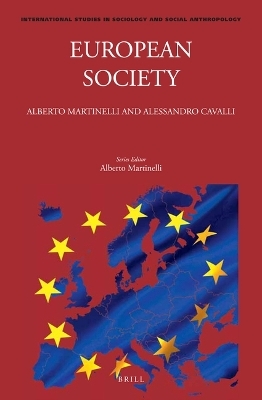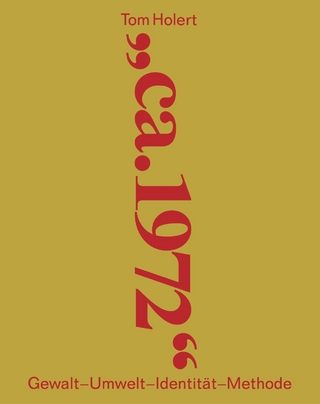
European Society
Brill (Verlag)
978-90-04-47144-3 (ISBN)
Alberto Martinelli, laurea in Economics (Milan, 1964); Ph.D. in Sociology (Berkeley, 1975), and Professor Emeritus of Sociology and Political Science, Milan. His most recent books include Global Modernization (Sage, 2005); Transatlantic Divide (Oxford University Press, 2007), and Mal di nazione (Bocconi University Press, 2013). Alessandro Cavalli, laurea in Economic History (Milan, 1963), and former Professor of Sociology at the University of Pavia, Italy. He has published several monographs on the history of sociology, youth, education, memory and time.
Tables and Figures
Introduction
1The European Identity
1 Preface: Identity and Identification
2 One or Many European Identities?
3 Rationalism and Individualism/Subjectivity
4 University and Scientific Research, Market Capitalism and Industrial Enterprise, Nation State and Polyarchic Democracy
5 An Unusual and Controversial Identity
6 Changes in the Content of European Identity and the Perception of their Meaning
7 How European Citizens’ Identification with Europe has Changed
8 Identity Techniques
9 The Renewed Relevance of the European Project
2 Nationalism
1 Nationalism as the Ideology of the Modern State
2 The Double Matrix of European Nationalism and Its Relationship with Democracy
3 Main Alternatives to the Modernist Approach
4 Nationalism in the First Decades of the 21st Century
5 Nationalism and the Contradictions of European Integration
6 Main Causes of the National/Populist Upsurge in Contemporary Europe
3 Languages
1 The Distant Past
2 The Recent Past
3 Multilingualism and Plurilingualism: Europe’s Inevitable Future
4 The Linguistic Policies of the EU
5 English as Lingua Franca
6 Languages and the Culture Industry
4 Religion and Religions
1 A Look at the Past
2 Rationalization, Modernization, and Secularization
3 Europe and America – A Comparison
4 The Return of Religiousness in New Forms
5 Contemporary Fundamentalism
6 Migration and Religious Pluralism
7 Religious Pluralism and Cosmopolitanism
5 The Universities
1 Introduction
2Studium Generale in the Middle Ages
3 The Universities on the Threshold of the Modern Age
4 The Birth of the Scientific Societies
5 University Models in the Age of the Nation States
6 From University for the Elites to University for the Masses
7 The Changing Relationship between Teaching and Research
8 Current Tendencies: Where Are European Universities Going?
6 The Cities
1 From the Ancient City to the Medieval City
2 State and Industry during the Formation of the Modern City
3 The Contemporary European City
7 Population and Family Structures
1 How Many Europeans Are There and How Many Will There Be?
2 Household Units and Family Structures
3 Declining Birth Rates
4 Couples, Families, and Reproductive Decisions
5 Fewer People Die and Live Longer
6 Social Policies for the Family
8 Internal and External Migrations
1 A Challenge (Also) to the Sense of Identity
2 The Europe as an Area of Emigration and of Immigration
3 Internal and External Migrations to the EU
4 The Reasons and Causes of Migration
5 The Migration Emergency of 2015 and Subsequent Years
6 Models and Ways of Integration
7 Stages and Obstacles in the Admissions/Integration Process
8 Xenophobic Movements and Welcoming Culture
9 Necessity of and Obstacles to a European Migration Policy
9 The Dimensions of Inequality
1 Rich and Poor People in Rich and Poor Countries
2 Dualism and Territorial Inequalities
3 Beyond Economic Inequalities in the EU
4 Conclusion
10 The Political-Institutional Architecture of the European Union
1 The EU as an Example of Bold Institutional Innovation
2 The Main Phases of European Integration
3 The Basic Institutions of the European Union
4 EU Decision-making
11 Parties, Elections, Pressure Groups
1 Transnational Party Federations
2 Transnational Party Federations and European Parliament Party Groups
3 The 2019 Elections of the European Parliament: Voter Turnout
4 The 2019 Elections of the European Parliament: Results and Recognized Party Groups
5 EP Elections Results in the Largest EU Member Countries
6 President Ursula von der Leyen’s Programme Priorities and the Composition of the New Commission
7 Interest Groups and Pressure Politics
12 The European Welfare State
1 Welfare and the European Social Model
2 Welfare State Models
3 Challenges Confronting the European Welfare State
4 The European Social Model as Common Core of European Welfare Systems
5 The Three Phases of European Welfare
6 The Effects of the Global Financial Crisis and the Reaction of European Welfare Regimes
7 The Critics from Opposite Sides
8 The Reformers: The Social Investment Approach
9 The Open Method of Coordination
10 Conclusion
13 The European Economy
1 Unity and Diversity of the European Economy
2 European Economic Development since the Start of the Integration Process
3 The 1970s Regime Change in the World Economy
4 The EU in the Global Market
5 The Choice of the Euro
14 The Global Financial Crisis
1 An Interpretation of the Global Financial Crisis
2 The Financial-Economic Crisis in the EU and the Predominance of the Intergovernmental Regime of Decision-making
3 The Stages of the EU Exit Strategy
4 The Crucial Role of the European Central Bank
5 Fiscal Stringency and a Difficult Return to Economic Growth
Conclusion
1 External Constraints, Internal Cleavages, and Reform of the European Union
2 Amending the Treaties
3 Reform Proposals under Existing Treaties
4 Key Decisions for Moving Forward a Greater Union
Afterword
Bibliography
Index
| Erscheinungsdatum | 10.08.2021 |
|---|---|
| Reihe/Serie | International Studies in Sociology and Social Anthropology ; 133 |
| Verlagsort | Leiden |
| Sprache | englisch |
| Maße | 155 x 235 mm |
| Gewicht | 656 g |
| Themenwelt | Geisteswissenschaften ► Archäologie |
| Geschichte ► Allgemeine Geschichte ► Zeitgeschichte | |
| Sozialwissenschaften ► Politik / Verwaltung ► Europäische / Internationale Politik | |
| ISBN-10 | 90-04-47144-8 / 9004471448 |
| ISBN-13 | 978-90-04-47144-3 / 9789004471443 |
| Zustand | Neuware |
| Haben Sie eine Frage zum Produkt? |
aus dem Bereich


